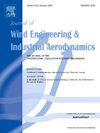双层电缆支撑光伏组件系统的风致响应和控制标准
IF 4.2
2区 工程技术
Q1 ENGINEERING, CIVIL
Journal of Wind Engineering and Industrial Aerodynamics
Pub Date : 2024-10-19
DOI:10.1016/j.jweia.2024.105928
引用次数: 0
摘要
缆索支撑光伏组件系统具有明显的风致振动特征。为了研究双索面支撑光伏组件系统的风致振动响应特性和机理,并进一步探讨刚度控制准则。通过气动弹性风洞试验研究了跨度为 35m 的新型索桁架支撑光伏组件系统的风致振动响应。首先,建立了符合气动弹性试验要求的比例气动弹性试验模型。然后,研究了风向、光伏组件倾角和稳定索初始预应力对均匀流和湍流场下风致振动响应特性的影响。最后,讨论了风致振动响应机理和刚度控制准则。结果表明,倾角增大会导致临界风速减小,0°风向最不利,增大初始预应力可提高临界风速,但效率较低。湍流流场下的临界风速比均匀流场下的临界风速高出约 30%。失稳振动是垂直弯曲和扭转的多模耦合振动的结果。建议采用 1/100 的刚度控制标准更为合适。该研究成果对电缆支撑光伏组件系统的设计和应用具有重要意义。本文章由计算机程序翻译,如有差异,请以英文原文为准。
Wind-induced response and control criterion of the double-layer cable support photovoltaic module system
The cable support photovoltaic module system has obvious characteristics of wind-induced vibration. In order to study the wind-induced vibration response characteristics and mechanism of the double-cable support photovoltaic module systems, and further discuss the stiffness control criterion. The wind-induced vibration response of a new type of cable-truss support photovoltaic module system with a span of 35m is studied through the aeroelastic wind tunnel test. Firstly, the scaled aeroelastic test model was established to meet the aeroelastic test requirements. Then, the effects of wind direction, PV module inclination angle, and stability cable initial prestress on the wind-induced vibration response characteristics under uniform flow and turbulent field are studied. Finally, the wind-induced vibration response mechanism and stiffness control criterion are discussed. The results show that the increase of inclination angle will lead to a decrease in critical wind speed, the 0° wind direction is the most unfavorable, and the increase of initial prestress can increase the critical wind speed but is inefficient. The critical wind speed under the turbulent flow field is about 30% higher than that of the uniform flow field. The instability vibration is the result of multi-mode coupled vibration of vertical bending and torsion. It is suggested that the stiffness control criterion is more appropriate as 1/100. The research results are of great significance for the design and application of the cable support photovoltaic module system.
求助全文
通过发布文献求助,成功后即可免费获取论文全文。
去求助
来源期刊
CiteScore
8.90
自引率
22.90%
发文量
306
审稿时长
4.4 months
期刊介绍:
The objective of the journal is to provide a means for the publication and interchange of information, on an international basis, on all those aspects of wind engineering that are included in the activities of the International Association for Wind Engineering http://www.iawe.org/. These are: social and economic impact of wind effects; wind characteristics and structure, local wind environments, wind loads and structural response, diffusion, pollutant dispersion and matter transport, wind effects on building heat loss and ventilation, wind effects on transport systems, aerodynamic aspects of wind energy generation, and codification of wind effects.
Papers on these subjects describing full-scale measurements, wind-tunnel simulation studies, computational or theoretical methods are published, as well as papers dealing with the development of techniques and apparatus for wind engineering experiments.

 求助内容:
求助内容: 应助结果提醒方式:
应助结果提醒方式:


